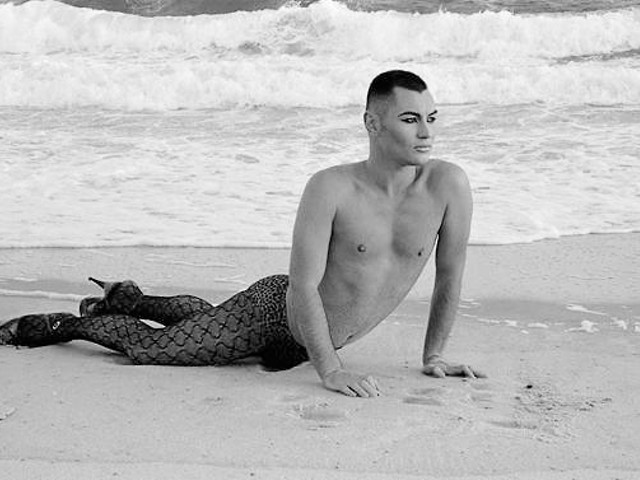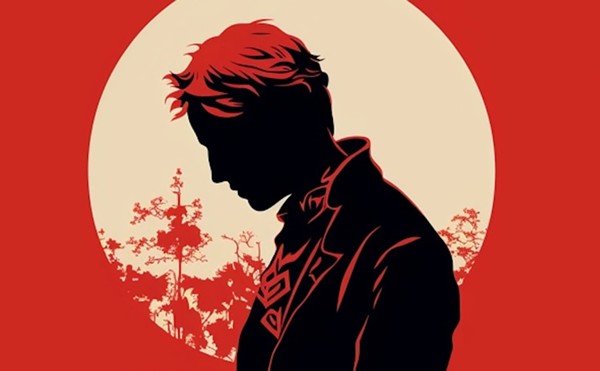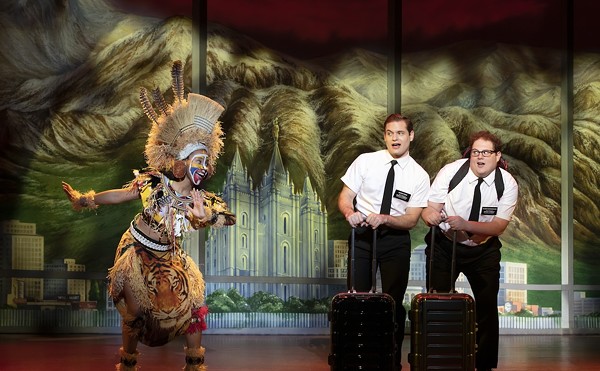Featured Review: Beyond XY Transgender photographer Loren Cameron (San Francisco) documents himself and other female-to-male subjects naked from head to toe, muscularly flexing or in straightforward exposure of their transitional bodies. Joshua McVeity (Calgary) and David Vance (Miami) see a more commercial aspect in the male physique, capturing young men in Calvin Klein briefs or bronzed, Grecian specimens in athletic contortions. Trix Rosen (New York) — whose earlier work discerned a new, lesbian street chic that developed post-Stonewall — follows a single male subject (a French performance artist) in various states of subtle drag in a recent series of portraits. An introduction by Washington University Women, Gender and Sexuality Studies professor Alexis Matza suggests that a "manaissance" is in our midst, wherein masculinity and, of course, femininity are now defined by qualities beyond chromosomes, hormones and genitalia. And yet classic paradigms persist here that suggest otherwise: a "man" is still something physical, and comprises broad musculature, chest hair, prominent genitals and facial hair (well, maybe not all three at once). Whatever the case, the show provokes innumerable questions — about the differences among art, documentary and kitsch; about erotica and and its non-titillating counterpart; about hetero- versus homosexual norms. In the end the primacy of the desire to attract others who will see one for who one wants to be is at the show's core — which seems as historically entrenched as the ancient statues to which some of the subjects pay homage. Through August 7 at phd Gallery, 2300 Cherokee Street; 314-664-6644 or www.phdstl.com. Hours: noon-4 p.m. Thu.-Sun.
Jay Wolke: Architecture of Resignation While traveling through the southern Italian region of Mezzogiorno, Chicago-based photographer Jay Wolke documented the incongruous encroachment of contemporary architecture (often in decay) on the elegant ruins and natural landscape of this historic countryside. A crumbling terra-cotta brick structure is punched through and re-settled into with a teal mattress and a nest of fast-food paper waste; a cliffside of cascading villas is overlooked by what appears to be a spankin'-new restaurant terrace outfitted with white plastic porch furniture; a lush botanical garden is edged by the garden's offices, the exteriors of which are girded by a hedgerow of electrical power sources, each sporting the company logo. The inelegance of the modern era's material culture (predominantly an American export) is made plain in these images by their harsh juxtaposition with the earthen stock of ancient structures. In a previous series, Wolke juxtaposed the congested Dan Ryan Expressway with its Chicago environs; the current project is a compelling analogue, only with a wider historical gap between its polar elements. Through September 4 at the Sheldon Art Galleries, 3648 Washington Boulevard; 314-533-9900 (www.thesheldon.org). Hours: noon-8 p.m. Tue., noon-5 p.m. Wed.-Fri., 10 a.m.-2 p.m. Sat.
Ongoing
Brandon Anschultz: Stick Around for Joy Compulsive exercises in the deconstruction of painting yield new forms of painterly pleasure in this year's Kranzberg exhibition, which features St. Louis-based painter, sculptor and printmaker Brandon Anschultz. Canvas is removed from the stretcher frame and wrapped into amorphous, folded sculptures; wall-hung canvases are flipped, revealing seeped-through imprints of paint; canvas is forgone altogether and replaced with fiberboard or plaster as the painting substrate, which then occasionally takes a sculptural shape; canvas is chewed into by saw cuts or severed in half. In the supreme act of creative desperation, piles of paintings on wood appear in a life-size bag after having been fed through a wood chipper. In challenging every method for taking apart and re-inventing the traditional parameters of painting, Anschultz illustrates both a capricious compendium of the medium's history and the peculiar plight of the artist at odds with his own expertise. An intense desire to unearth something both fundamental and fresh seems to lie at the heart of this exhibition. Whether that desire is fulfilled is not entirely the issue; rather, the rigorous and playful spirit that pervades the exhibit is its most rare discovery — and one made solely on the work's own terms. Through September 26 at Laumeier Sculpture Park, 12580 Rott Road, Sunset Hills; 314-821-1209 or www.laumeier.com. Hours: 10 a.m.-5 p.m. Tue.-Sat., noon-5 p.m. Sun. (Outdoor grounds open daily from 8 a.m. to a half-hour past sunset).
Erik Spehn: Tape Drawings Strips of masking tape used in the creation of this St. Louis-based painter's signature woven-pattern acrylics on canvas are reused in this series of small works on matte board. While calling these pieces "drawings" may imply that they're not as formidable as their painted counterparts, the exhibit proves otherwise. Arranged in chromatic groups, crosshatchings of red-, then maroon-, then blue-flecked strips appear to explore different approaches to pattern. Wide swaths of tape overlap in loose diffusions, while minute, finely cut pieces interweave in tight grids. As one moves through the gallery, the palette brightens, opening up to a full room of yellow- and golden-hued pieces that seem to be uttering among themselves a complicated language in lines, layers and other distinct and serial marks. Through September 18 at the Sheldon Art Galleries, 3648 Washington Boulevard; 314-533-9900 or www.thesheldon.org. Hours: noon-8 p.m. Tue., noon-5 p.m. Wed.-Fri., 10 a.m.-2 p.m. Sat.
Focus on Photography: Recent Acquisitions This exhibit of new additions to the Kemper's collection concisely and powerfully charts the development of photography from its early, documentary-inflected use to its transformation into a contemporary expressionistic medium. The sepia-toned historic portraits in Edward Curtis' North American Indian series presage the medium's impressionistic capacity, its subjects appearing less objectively culturally situated as romantically (and exotically) framed with a foreboding sense of nostalgia. A collection of 1970s and '80s-era Polaroids by Andy Warhol functions somewhat similarly: Lesser-known luminaries can be seen as instantaneously vulnerable and self-consciously postured. Christian Jankowski, who in 2005 photographed Washington University students at the annual campus poster sale, doubles this sense of photography's capacity to capture its own late-capitalist commodification as an image-making device. Artwork appears as both a witless and poised subject in Louise Lawler's Not Yet Titled (2004), wherein Gordon Matta-Clark's raw building fragment, Bingo, is institutionalized in the renovated galleries of New York's Museum of Modern Art. Finally, the photograph becomes an abstraction in itself in Wolfgang Tilman's Silver 71 (2008), ushering in an era in which photography is an artistic medium, nothing more and nothing less. Also showing: 2010 MFA Thesis Exhibition; this year's survey of graduate work includes notable pieces by John Early, Ryan Fabel, Joel Fullerton, Dani Kantrowitz and Mamie Korpela. Through July 26 at the Mildred Lane Kemper Art Museum, Forsyth & Skinker boulevards (on the campus of Washington University); 314-935-4523 or www.kemperartmuseum.wustl.edu. Hours: 11 a.m.-6 p.m. daily (closed Tue., open till 8 p.m. Fri.)
Great Rivers Biennial A consciousness of art's ability to speak to issues beyond itself pervades this triptych of large-scale installations by the three recipients of this coveted regional honor. In Martin Brief's Amazon God, scrolls depicting what appear to be EKG or seismography charts betray, upon closer inspection, meticulous handwritten lists of books culled from an Amazon.com title search for the word "God." The lists run the gamut of categories, from Religion to Fiction to Food: "God" proves to be ubiquitous, elusive and highly marketable. Sarah Frost's Arsenal is a cascade of firearms, crafted out of white paper, that dangle from transparent strands and look alternately like an onslaught of bones and a static snowfall. The guns were constructed from instructional videos made by children and uploaded onto YouTube, revealing a peculiar community that has an eerily playful (and sophisticated) notion of firearm mechanics. Cameron Fuller's From the Collection of the Institute for the Perpetuation of Imaginal Processes is a world unto itself, a pastiche of modes of museum display and a homage to creativity: A diorama of taxidermied wildlife moves between environmental realism and theatrical camp; vitrines of cardboard masks are interspersed amid a sepia-toned video of a dancing bear, a salon-style display of mid-century photographs of disasters and a bright carnival trailer that imbues the entire work with hints of hucksterism. All three artists have moved beyond physical aesthetics to the realm of social commentary and the use of art to explore and expose cultural sub-currents. Through August 8 at the Contemporary Art Museum St. Louis, 3750 Washington Boulevard; 314-535-4660 or www.contemporarystl.org. Hours: 10 a.m.-5 p.m. Wed.-Sat., 11 a.m.-4 p.m. Sun.
The Mourners: Tomb Sculptures from the Court of Burgundy Carefully extracted from their otherwise permanent context in the base of the elaborate tomb of the medieval French duke John the Fearless, these 40 alabaster sculptures exude a presence and formidable craft beyond their two-foot scale. Portrayed in a kind of perpetual procession, led by a choirboy, several deacons and a bishop, the series of heavily cloaked monks appear in various states of ritualistic or personal mourning — consulting small, opened scriptural tomes or entirely enshrouded in ceremonial dress. The pieces are modest and elegant but sculpted to such an articulate degree that they withstand being taken each on their own silent terms. And yet the oppressive apparatus of this traveling exhibition, which reiterates at every opportunity the pieces' power and skill in portraying grief, so far overstates the work's merit that one almost feels compelled to deny them it. Shown in tandem with the contemporary (2008) video installation, Visitation, by Bill Viola, the effect feels even more bombastic. In the video, two older women lead one another into and out of a deluge of water and then into the grainy ether of the far distance. It's a haunting and ethereal piece that, nonetheless, feels overly literal when coupled with the equally direct symbolism of the tomb sculptures. Through September 6 at the Saint Louis Art Museum, 1 Fine Arts Drive (in Forest Park); 314-721-0072 or www.slam.org. Hours: 10 a.m.-5 p.m. Tue.-Sun. (10 a.m.-9 p.m. Fri.)
Nothin' But the Blues: Art and Writing by Area Students A latticework of blue and rainbow-hued stripes rendered in wavering crayon lines; pencil sketches of Robert Johnson, Chuck Berry and Tina Turner in wild pencil lines; a blue steamboat on a sea of lips, eyes and blue trains — this collection of grade schoolers' artworks inspired by blues music is an oddly sophisticated and emotionally honest display. The Airport Elementary School students' homages are interspersed with their own blues lyrics, plainly and repeatedly lamenting "I cried and cried" or triumphantly asserting "Don't let nobody drag your spirit down" and "I am confident in myself." The simple-seeming sentiments ring of unaffected truth — wisdom, even — in equal measure to the awkward sincerity of the drawings and paintings, all of which appear to be excavated from bold inner sources of maturity. Viewed another way, though, such moments of poetic and visual invention are perhaps unattainable with the poise, self-consciousness and the wearied finesse of age. Through August 14 at the Sheldon Art Galleries, 3648 Washington Boulevard; 314-533-9900 orwww.sheldonconcerthall.org. Hours: noon-8 p.m. Tue., noon-5 p.m. Wed.-Fri., 10 a.m.-2 p.m. Sat.
St. Louis Point of View UMSL's Public Policy Research Center Photography Project enlisted local community groups to document neighborhoods in photos, focusing on historic preservation, adult/youth enrichment and community revitalization. Culled from six years' worth of photographs, the resulting exhibit is nothing short of astonishing. Melva Taylor's Untitled (It Looks Like New York) depicts an angular corridor between high-rise housing complexes in JeffVanDerLou. Preshis Mosley turns a dislodged water fountain in a forlorn park off North Skinker Boulevard into No Water at All (What We Don't Like). Tanya Long captures Granite City's neglected downtown reflected in wavering glass. In After Keita and Sidibe: Ralph Tyler, Jenele Brooks poses a youth in the manner of mid-century African studio photography. One unsigned work, a self-portrait, consists of an image of the photographer's sole possession: a corduroy jacket. Again and again the "amateur" eye strips an environment of the usual aesthetic appeals and distills it to crucial essentials and unexpected details. Through August 22 at the Missouri History Museum, 5700 Lindell Boulevard; 314-746-4599 or www.mohistory.org. Hours: 10 a.m.-6 p.m. daily (open till 8 p.m. Tue.).
Upside Down Clouds In a compact but immersive assortment of surreally portentous drawings, sculpture and unnamable artifacts, St. Louis-born sister-and-brother artists Gena Sophia and Jason Wallace Triefenbach plumb the psyche and its mysterious ways. Which work is by whom is indistinguishable; the dual project seems to be about channeling something mystical — or, at least, out of one's own hands — when engaging in creative acts. A massive open mouth, tongue hanging, is drawn in rough black lines; "Rise Like Music" is scrawled across another page. Pyramidal shapes — cast in concrete and stacked in a pile, or appearing in drawings where they emit all-seeing-eye beams of light — evoke an occult semiotics, as though Aleister Crowley and Kenneth Anger alike are being paid homage. Large Xerox images of ancient gods appear pasted on the wall without further script, as though their aura and purpose need no explanation. As a whole, it's a cacophonous world reigned over by the id, whose raw energy has its own authentic and inimitable rigor, even while toeing the line of disorder. Through July 31 at PSTL Gallery at Pace Framing, 3842 Washington Boulevard; 314-531-4304 or www.paceframing.com. Hours: 10:30 a.m.-5 p.m. Tue.-Sat.
Vatican Splendors: A Journey Through Faith and Art This traveling exhibit of papal artifacts is a tour de force of high kitsch. Multimedia displays selectively detail the grandeur of the Catholic Church in a manner that alternately suspends and dismantles disbelief. Genuine items from the Vatican's collection are outnumbered by simulacra intended for spiritual transport, including a full-scale reproduction of Michelangelo's Pietà, a walk-through re-creation of the scaffolding used to paint the Sistine Chapel, a cast of Pope John Paul II's hand (which you can touch), a plaster cast of a fragment of the "red wall" from the sepulcher of St. Peter and innumerable digital reprints of immersive building environments, historic documents and artwork. There are moments of true beauty: fragments of Roman and Byzantine-era mosaics; two gold chalices and other papal liturgical items; a maddeningly intricate reliquary containing minuscule bodily fragments of Saints Peter, Paul and Anne; and Deposition in the Sepulcher, painted by the first art gossip, Giorgio Vasari. Strangest of all is the section devoted to global proselytizing; depictions of the conversion of non-Catholic cultures would seem to be something to shield one's eyes from. Suffice to say it's a trip, complete with gift shop. Through September 12 at the Missouri History Museum, Lindell Boulevard and DeBaliviere Avenue; 314-746-4599 or www.mohistory.org. Hours: 10 a.m.-6 p.m. daily (open till 8 p.m. Tue.).





